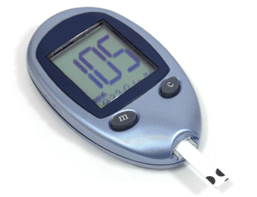National Diabetes Awareness Month
 Diabetes is the 7th leading cause of death in the United States. One in 11 people have diabetes today and over 86 million people are at risk for developing diabetes. Yes, you read that right.
Diabetes is the 7th leading cause of death in the United States. One in 11 people have diabetes today and over 86 million people are at risk for developing diabetes. Yes, you read that right.
Do you want to know what the scary part is about that statistic? Diabetes is 100% manageable. November is the perfect month to talk about diabetes because it is National Diabetes Awareness Month and 11/14 is World Diabetes Day.
What is Diabetes?
Diabetes is a disorder where you have an increase of glucose, or sugar, in your blood. It does not discriminate- it can affect anyone, child or adult, male or female. The most common types of diabetes are type 1, type 2 and gestational diabetes.
Type 1 Diabetes
Type 1 diabetes is a condition where the pancreas makes little to no insulin. This can be caused by genetics and other unknown factors.
Insulin is a hormone made by the beta cells of your pancreas that helps regulate your blood glucose levels. If your body does not make it, you may develop high blood glucose, or hyperglycemia, because the glucose cannot get into the cells and therefore stays in the blood. This condition can cause long-term complications if left untreated.
Type 1 diabetes affects ~5% of people who have diabetes and is usually diagnosed in children and young adults.
Unfortunately there is no cure for type 1 diabetes. But, with medication and a healthy meal pattern, you are able to live a fairly normal lifestyle.
Type 2 Diabetes
Type 2 diabetes is a condition where your body improperly uses insulin or builds insulin resistance. This is caused by genetics and lifestyle factors. The pancreas pumps out more insulin to compensate for insulin resistance. If this process occurs over time, your pancreas will get worn out and eventually won’t make enough insulin. This will leave glucose in the blood instead of moving it into cells.
About 90-95% of people who have diabetes have type 2.
There are known risk factors that can lead to the development of type 2 diabetes. They include: being overweight, 45 years of age and older, having a parent or sibling with diabetes and being physically inactive.
Once you have type 2 diabetes you always have it. You are not able to cure it. But, you might be able to get it under control and no longer need medication.
What is the best way to treat your type 2 diabetes? Work with a Registered Dietitian Nutritionist that is a Certified Diabetes Educator (contact me here). I can help you develop a meal plan with a consistent carbohydrate intake tailored to your nutritional needs and lifestyle. I will also help you develop an appropriate exercise regime. Exercise can lower your blood glucose levels by enhancing your cell’s sensitivity to insulin.
Gestational Diabetes
Gestational diabetes is exclusive to pregnant woman. Most women are given a glucose screening test between 24 and 28 weeks to check for it. It is identified when a woman has higher than normal blood glucose levels, but has never had diabetes before.
If you develop gestational diabetes, talk to your OBGYN about the appropriate next steps and reach out to a Registered Dietitian Nutritionist that is a Certified Diabetes Educator for more guidance.
November is about drawing attention to the need for diabetes education.
Education is the first step towards prevention and treatment of this common disease.
Managing diabetes isn’t easy; so offering your best support to others with the disease is important. See a Registered Dietitian Nutritionist and Certified Diabetes Educator for personalized self-management diabetes education (contact me here).
Your turn to take action: How can you help spread awareness on how to prevent or treat Diabetes today?

Leave a Reply
Want to join the discussion?Feel free to contribute!